Shoulder Dystocia During Childbirth
Shoulder dystocia can permanently impact a child’s movement and cause hypoxic brain injuries, bone fractures, and even death. Obstetricians, nurses, and other healthcare professionals must understand and recognize the risks when shoulder dystocia presents. They must know how to effectively treat and know how to avoid it when possible by performing a C-section delivery.
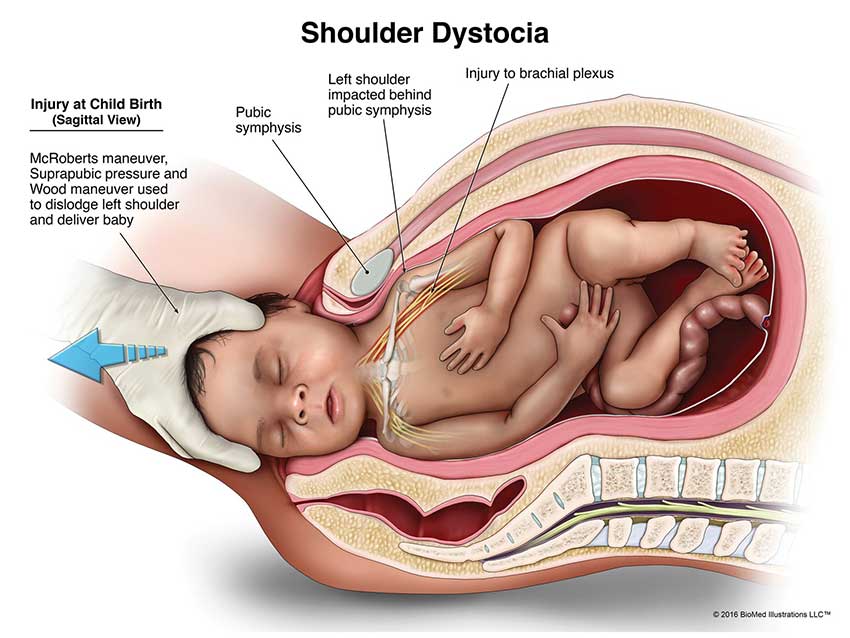
Cases of shoulder dystocia that prolong a mother’s labor can put both her and her baby in grave danger. The baby’s access to oxygenated blood gets cut off, putting them at risk for hypoxic (lack of oxygen) and ischemic (lack of blood flow) brain injuries, such as hypoxic ischemic encephalopathy (HIE). HIE is a serious brain injury that is often marked by paralysis, seizure disorders, and cognitive and developmental delays. It is also the leading cause of cerebral palsy.
A newborn can sustain a devastating birth injury without proper treatment during and after improperly-treated labor and delivery complications. Miller Weisbrod Olesky has a decades-long track record of results for children and families across the United States who have suffered from birth injury malpractice.
Free Legal Consultation
Birth Complication Lawyers
1-888-987-0005Our Birth Injury Lawyers are available to meet you in your home or the hospital.
Our team of specialized birth injury attorneys and registered nurses can review the unique circumstances of you or your family’s case to deliver the treatment, care, and financial resources you deserve. You won’t be charged with any fees until we win your case.
What Is Shoulder Dystocia?
Shoulder dystocia is a labor and delivery complication that occurs when one or both of the baby’s shoulders become stuck behind the mother’s pubic bone in the pelvis. It is typically diagnosed within one minute after the baby’s head delivers, but the rest of the body remains lodged inside the birth canal.
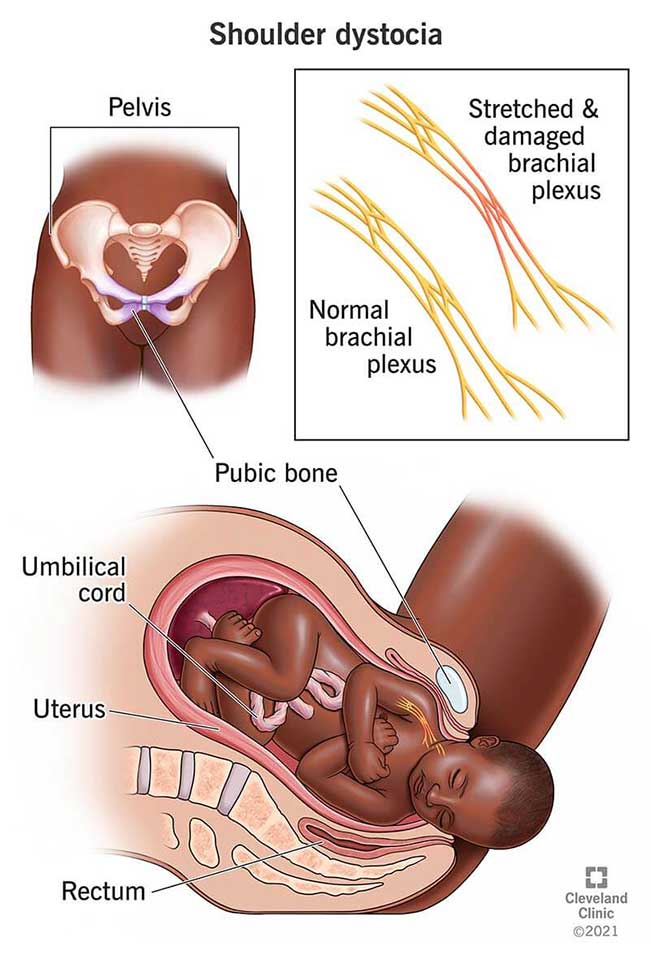
Shoulder dystocia is rare, estimated to occur in between 0.7% and 3% of all births. There are no symptoms that appear beforehand to indicate that shoulder dystocia will happen, but there are several causes and risk factors for it.
What Causes Shoulder Dystocia?
Shoulder dystocia is typically caused by the fetus being larger than average, known as macrosomia. A baby is considered macrosomic when they exceed a birth weight of 8 pounds, 13 ounces.
Other factors, such as an abnormal fetal position or cephalopelvic disproportion (a mismatch between the baby’s head size and the mother’s pelvic shape), can also cause shoulder dystocia.
What Are Risk Factors for Shoulder Dystocia?
While cases of shoulder dystocia cannot be predicted with 100% accuracy, there are several risk factors that may increase the odds of it occurring during a mother’s labor. These risk factors include:

- Maternal Obesity: Maternal obesity increases the child’s likelihood of being macrosomic, as well as increases their chances for having other risk factors like gestational diabetes.
- Gestational Diabetes: According to researchers, about 15 to 45 percent of the babies born to women with gestational diabetes may have macrosomia. This is a common adverse outcome of gestational diabetes and increases the odds of a shoulder dystocia event.
- Abnormal Pelvic Shape: If a mother’s pelvic shape is smaller than average (due to genetics or from other factors such as a short stature), they may be at a higher risk for cephalopelvic disproportion (CPD). Cases of CPD greatly increase a child’s risk for shoulder dystocia.
- Abnormal Fetal Positioning: Abnormal fetal positions such as breech position or shoulder position can be a risk factor for shoulder dystocia and may make vaginal birth impossible.
- Post Term Pregnancy: A post term pregnancy baby (someone born beyond the normal gestational period of 37-42 weeks) has a higher likelihood of having a high birth weight due to the extra time developing in the womb.
If a baby or mother has one or more of these risk factors, a planned C-section delivery should be considered to minimize the risk of shoulder dystocia and a prolonged or arrested labor.
What Health Complications Can Shoulder Dystocia Cause?
Shoulder dystocia can cause severe harm to both the mother and her baby. Complications can include:

- Birth Asphyxia: This is the primary concern with shoulder dystocia cases as a baby can only withstand so much time without oxygenated blood flowing through to their brain. Shoulder dystocia cuts off that circulation to the baby’s head, increasing their risk for brain damage.
- Brain Injury: Shoulder dystocia increases the baby’s risk for permanent brain injuries such as hypoxic ischemic encephalopathy.
- Nerve Damage & Paralysis: Shoulder dystocia can cause irreparable damage to the baby’s brachial plexus nerve in the neck, which is responsible for controlling movement in the upper body.
- Bone Fractures: The baby’s clavicle (collar bone) is at risk for fracturing with shoulder dystocia. In some emergency cases, obstetricians may intentionally break this bone to help release the baby’s shoulders so they can pass through the birth canal.
- Umbilical Cord Compression: With shoulder dystocia, the umbilical cord commonly gets stuck between the child’s arm and the mother’s pelvic bone. This can flatten or compress the cord, restricting oxygen and blood from traveling to the child.
- Uterine Rupture: The stress on the mother’s womb with shoulder dystocia can sometimes cause the uterus to tear, which can cause further complications for the mother.
- Postpartum Hemorrhage: Following a shoulder dystocia complication, a mother may experience uterine tears or perineum tears (the area between the anus and the vagina). This can cause heavy postpartum bleeding.
How Is Shoulder Dystocia Treated?
There are multiple methods that obstetricians can use to treat a child’s shoulder dystocia. They include:
Suprapubic Pressure
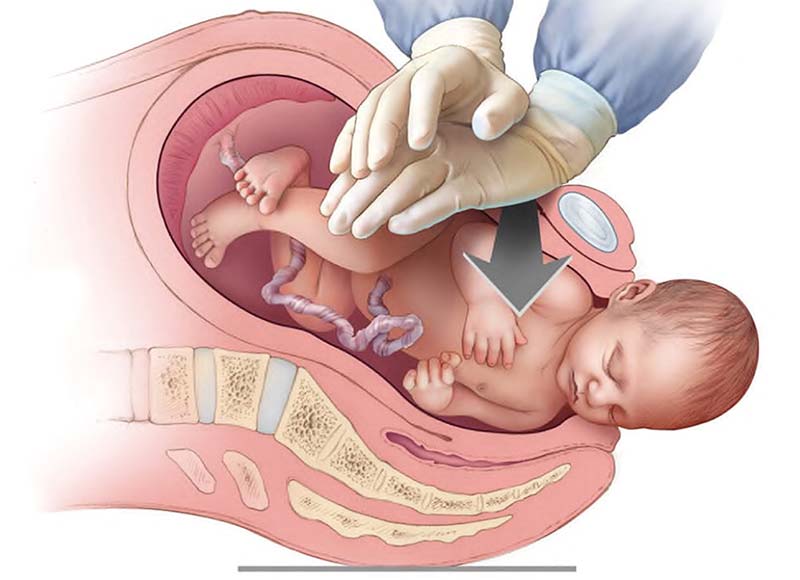
This technique involves pressing down on the mother’s lower abdomen to help ease the baby through the birth canal.
McRoberts Maneuver
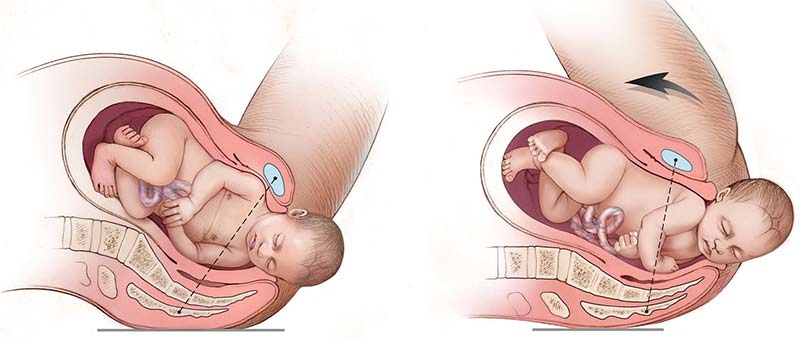
The McRoberts maneuver involves flexing the mother’s thighs tightly toward her abdomen while shifting her hips away from her body. It can help to move the pubic bone joint by a few centimeters, as well as potentially shift the baby’s shoulders.
Wood’s Maneuver
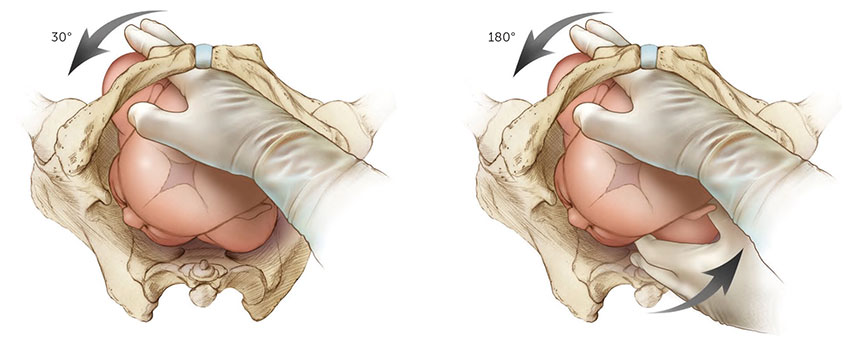
The Wood’s Screw maneuver is used when the obstetrician carefully twists the child’s head and shoulders to slowly ease the baby out of the stuck position. This technique is commonly butchered and has the potential to cause further harm if done improperly.
Assisted Delivery Instruments

Use of Delivery Instruments: In some cases, healthcare professionals may use external tools like forceps and vacuum extractors to get the baby unstuck. Like the other techniques, these tools can cause further harm when used improperly.
Zavanelli Maneuver
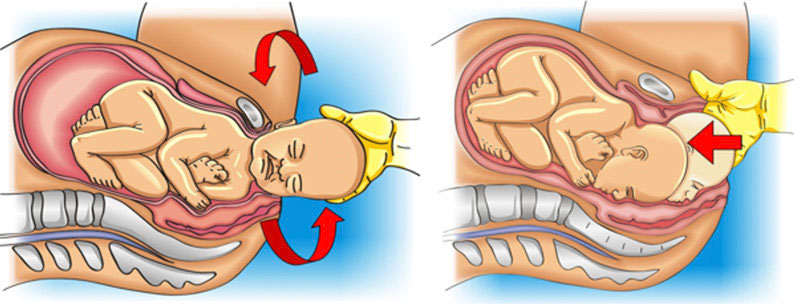
When all other methods fail, the Zavanelli maneuver involves pushing the baby back up into the birth canal for an emergency C-section delivery.
If doctors deem a pregnancy to be high-risk for shoulder dystocia, they may opt to perform a C-section delivery to avoid the potential complications of a vaginal birth. After the child is safely delivered, healthcare professionals must scan them for any potential injuries and treat them promptly.
What Mistakes Can Healthcare Providers Make in Shoulder Dystocia Cases?
Doctors must avoid making these critical medical errors so they don’t unintentionally cause further harm to a child experiencing shoulder dystocia:

- Failure to identify or properly assess a mother’s risk factors for shoulder dystocia, such as maternal obesity, gestational diabetes, abnormal fetal positioning, and macrosomia.
- Applying fundal pressure (pressure to the top of the woman’s abdomen) during labor, resulting in harm to the mother or child.
- Applying excessive force when implementing the McRoberts, Wood’s Screw, or Zavanelli maneuvers.
- Improper usage of assisted delivery instruments that causes an injury to the mother or child.
- Failure to order a timely C-section delivery, resulting in prolonged oxygen deprivation.
- Failure to address injuries that follow a shoulder dystocia event, such as a mother’s uterine rupture or hemorrhaging.
It’s important to note that it requires a detailed review of the specific facts and timeline of a mother’s birth and the action taken shortly after it before making a definitive judgement as to whether medical malpractice played a factor in your or your child’s shoulder dystocia injury.
Was My Child’s Shoulder Dystocia Injury the Result of Medical Malpractice?

Shoulder dystocia can be prevented or alleviated with proper medical care. Medical negligence, such as applying fundal pressure or failing to order a timely C-section delivery, can worsen a newborn’s health and expose them to potential lifelong injuries.
If a family believes medical negligence contributed to a child’s birth injury, legal support may be an option. A specialized birth injury attorney can review the medical records and circumstances to assess whether a claim exists.

Parents whose children suffer from the long-term effects of birth complications, as well as parents who have suffered the loss of their baby, deserve to know whether it could have been prevented. Our dedicated birth injury lawyers want to help you find those answers and obtain the funds necessary to improve the quality of life for your child.
If your child has been diagnosed with a birth injury and you suspect this may have been caused in part by medical mistakes, Miller Weisbrod Olesky will thoroughly investigate the facts and hold the responsible medical providers accountable by pursuing medical malpractice claims against them.
Sometimes families are hesitant to reach out to a medical malpractice attorney or law firm. They may feel overwhelmed by their circumstances or are worried that a law firm will not be able to help them. But the only way to find out if you have a case is to talk to an attorney who understands how birth injuries can lead to developmental delays and other complications that require long-lasting medical support.
What Is the Statute of Limitations in a Birth Injury Case?

A statute of limitations (SOL) is a law that sets a time limit on how long an injured person has to file a lawsuit after an accident. It is essential to understand that statutes of limitations vary based on the type of case and the state where it is filed. For instance, the deadline for birth injury claims is typically different from other claims, such as injury to personal property, fraud, contract disputes, and collection of debts.
Generally, the clock starts ticking on the date the injury occurred. However, there are exceptions to this rule, and in some cases, the statute of limitations starts when a person discovers or reasonably should have discovered an injury. When dealing with government agencies, SOLs can become even more complex.
For example, if the party that injured you was:
- A federal employee
- Employed by a military hospital, Veterans Administration facility, or a federally funded medical entity
You may need to file a birth injury claim under the Federal Tort Claims Act (FTCA). In FTCA cases, claimants must go through certain administrative procedures before filing a lawsuit. In some states, if the negligent party was a local or state government hospital or the doctors and medical providers are employees of a governmental entity, the time period in which you must give "notice" may be shorter.
If your case is filed outside of the statute of limitations, it will typically be dismissed, and you will not be eligible to recover compensation for your injuries. Determining when a statute of limitations begins on your case can be tricky. If you're considering pursuing compensation for a birth injury, contacting an attorney as soon as possible is in your best interest.
How The Birth Injury Attorneys at Miller Weisbrod Olesky Can Help

Birth injuries caused by shoulder dystocia can sometimes be prevented, but it takes a detailed expert review of the facts and circumstances of your pregnancy and your child's birth to determine whether the injury was the result of medical malpractice.
Our Process
At Miller Weisbrod Olesky, a team of committed birth injury attorneys, nurses and paraprofessionals uses our detailed medical negligence case review process to assess your potential birth injury case. We start by learning more about you and your child and the status of meeting/missing developmental milestones. Then we gather medical records to determine what happened before, during, and after your delivery. We call in skilled medical experts who review your records and let us know if they think medical errors could have caused you or your child's injuries.
If we feel medical negligence caused or contributed to complications with your pregnancy or your child's injuries, we meet with you to discuss how you can receive compensation from the medical professionals who made the errors.
At no point in our legal intake process will we ask you to pay anything. The medical review of your case and the consultation are free. We only receive payment when you do. The sooner you reach out to us, the sooner we can begin investigating your case and gathering the evidence needed to support your claim.
We work on a contingency fee basis, meaning you won't pay any legal fees unless we win your case. Contact us today to schedule your free consultation by calling our toll-free line at 888-987-0005 or by filling out our online request form.
